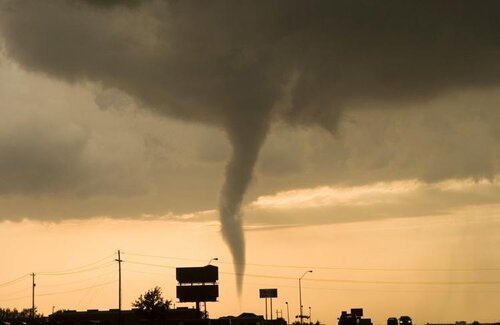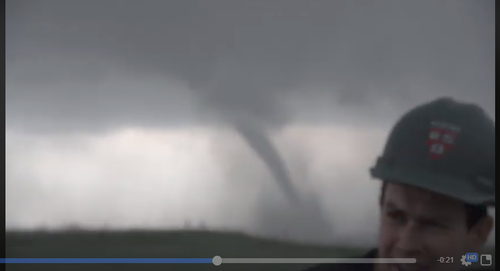Maybe if the people writing about leaving the hobby will actually leave the hobby our roads will be less congested?
From the Tulsa World - Original article here

I had heard grumblings about the downsides to storm chasing for a long time — poor driving habits, traffic jams as cars converge near violent storms and the dangers of rogue chasers and hobbyists. It had always been on my mind, but four years of venturing to the Plains had taught me it was just something I’d have to live with. I always brushed it off as an unavoidable byproduct of chasing.
But Monday was different. I witnessed firsthand the practices that will drive me away from the sport I once loved with my entire being. The past week of storm chasing has been eye-opening. In just seven days, I’ve encountered:
There’s a reason why my biggest fear about storm chasing isn’t weather-related; it’s not the softball-sized hail, it’s not hurricane-force winds and it’s not even lightning or the tornado. It’s other chasers. On Monday, when a large tornado passed by Mangum, Oklahoma, the Oklahoma Highway Patrol reported just one injury, not from wind but “involving two vehicles with storm chasers.”
The perils have been manifest before. Three storm chasers were killed in an accident in Texas on March 28, 2017, when a pair of Weather Channel contractors blew through a stop sign at 70 mph. In 2013, veteran storm chaser Tim Samaras fell victim to a tornado near El Reno, Oklahoma; his son, Paul, and chase partner Carl Young also perished. A Weather Channel vehicle was tossed 200 yards, breaking the driver’s neck. Scores of other chasers cheated death that day.
But so far, the storm-chase community has been incredibly lucky. On its current track, storm chasing is a ticking time bomb. It’s only a matter of time before a major catastrophe occurs — with many more fatalities. Chaser-clogged roads and an erratically moving tornado are a recipe for disaster. It’s not a matter of if — it’s when.
Much of the problem stems from the sheer number of chasers on the road. Back in the 1970s and ’80s, there were only a handful out there. Those who were were generally trained atmospheric scientists who understood the dynamics of what they were dealing with.
But the mid-2000s ushered in an era of do-it-yourself storm chasing — popular TV shows such as the Discovery Channel’s “Storm Chasers” and the advent of smartphones spurred many to think, “I can do this.” And in many cases, they can. But in my opinion, they shouldn’t.
It’s easy to turn on the TV and see a severe weather risk area plastered on a map. Driving to it is simple. And nowadays, high-resolution computer models are made available to the public online. The sheer amount of information out there gives the tools of the trade to anybody. But that doesn’t mean they know how to use them.
Storm behaviors change. Cell service drops out. And computer models are often shaky at best. Today’s “home-grown” storm chasers may have what they need to get by 99 percent of the time. It’s easy to know what to do when things go right. But it’s only a matter of time before things go wrong.
It’s not just amateurs contributing to this chasing turning point. “Professional” storm chasers, too, are only making it worse. With stiffer competition and more of it, many are taking to the extreme to get the best, most up-close footage. This often means taking unnecessary risks and putting others at risk as well. Yet time and time again, it’s gobbled up by the public, encouraging this “bad behavior” further.
Branding things as “extreme” gets clicks and views. That makes money. And across the board, we’re much more likely to celebrate an “extreme storm chaser” than we are a “safe storm chaser.” You’re not going to turn on the TV and see a headline that reads “storm chaser records tornado from a safe distance.”
It’s part of a larger cultural issue that’s in the process of redefining storm chasing. For many, the practice we fell in love with simply doesn’t exist anymore.
And with big profits on the line, the dangerous behavior will only get worse. Illegal driving won’t be policed by law enforcement; they’re busy during severe weather. And there’s no real way to limit practically the number of storm chasers or tourists that venture out.
It’s going to get worse before it gets better. And it will take a major event to drive greater change and prompt discussions about the sport in general.
Maybe it’ll be from more devastating car accidents. Perhaps a tornado will sweep over a chaser traffic jam. Or maybe an “extreme” storm chaser won’t have dumb luck on their side. The number of things that can go wrong are endless.
And one of these days, they will.
Matthew Cappucci is a reporter for The Washington Post.
From the Tulsa World - Original article here

I had heard grumblings about the downsides to storm chasing for a long time — poor driving habits, traffic jams as cars converge near violent storms and the dangers of rogue chasers and hobbyists. It had always been on my mind, but four years of venturing to the Plains had taught me it was just something I’d have to live with. I always brushed it off as an unavoidable byproduct of chasing.
But Monday was different. I witnessed firsthand the practices that will drive me away from the sport I once loved with my entire being. The past week of storm chasing has been eye-opening. In just seven days, I’ve encountered:
- Chase vehicles parked perpendicular to roads blocking major intersections
- Multiple chasers with red/blue police lights “pulling over” others to clear their path to the storm; in 70 mph winds and egg-sized hail and less than a mile from a tornado, this could have been deadly
- Traffic jams 200 cars deep
- Chasers parking on/in the road to take pictures, blocking traffic
- Chasers barreling down a one-lane road at 90 mph
- Chasers driving on the wrong side of the road
There’s a reason why my biggest fear about storm chasing isn’t weather-related; it’s not the softball-sized hail, it’s not hurricane-force winds and it’s not even lightning or the tornado. It’s other chasers. On Monday, when a large tornado passed by Mangum, Oklahoma, the Oklahoma Highway Patrol reported just one injury, not from wind but “involving two vehicles with storm chasers.”
The perils have been manifest before. Three storm chasers were killed in an accident in Texas on March 28, 2017, when a pair of Weather Channel contractors blew through a stop sign at 70 mph. In 2013, veteran storm chaser Tim Samaras fell victim to a tornado near El Reno, Oklahoma; his son, Paul, and chase partner Carl Young also perished. A Weather Channel vehicle was tossed 200 yards, breaking the driver’s neck. Scores of other chasers cheated death that day.
But so far, the storm-chase community has been incredibly lucky. On its current track, storm chasing is a ticking time bomb. It’s only a matter of time before a major catastrophe occurs — with many more fatalities. Chaser-clogged roads and an erratically moving tornado are a recipe for disaster. It’s not a matter of if — it’s when.
Much of the problem stems from the sheer number of chasers on the road. Back in the 1970s and ’80s, there were only a handful out there. Those who were were generally trained atmospheric scientists who understood the dynamics of what they were dealing with.
But the mid-2000s ushered in an era of do-it-yourself storm chasing — popular TV shows such as the Discovery Channel’s “Storm Chasers” and the advent of smartphones spurred many to think, “I can do this.” And in many cases, they can. But in my opinion, they shouldn’t.
It’s easy to turn on the TV and see a severe weather risk area plastered on a map. Driving to it is simple. And nowadays, high-resolution computer models are made available to the public online. The sheer amount of information out there gives the tools of the trade to anybody. But that doesn’t mean they know how to use them.
Storm behaviors change. Cell service drops out. And computer models are often shaky at best. Today’s “home-grown” storm chasers may have what they need to get by 99 percent of the time. It’s easy to know what to do when things go right. But it’s only a matter of time before things go wrong.
It’s not just amateurs contributing to this chasing turning point. “Professional” storm chasers, too, are only making it worse. With stiffer competition and more of it, many are taking to the extreme to get the best, most up-close footage. This often means taking unnecessary risks and putting others at risk as well. Yet time and time again, it’s gobbled up by the public, encouraging this “bad behavior” further.
Branding things as “extreme” gets clicks and views. That makes money. And across the board, we’re much more likely to celebrate an “extreme storm chaser” than we are a “safe storm chaser.” You’re not going to turn on the TV and see a headline that reads “storm chaser records tornado from a safe distance.”
It’s part of a larger cultural issue that’s in the process of redefining storm chasing. For many, the practice we fell in love with simply doesn’t exist anymore.
And with big profits on the line, the dangerous behavior will only get worse. Illegal driving won’t be policed by law enforcement; they’re busy during severe weather. And there’s no real way to limit practically the number of storm chasers or tourists that venture out.
It’s going to get worse before it gets better. And it will take a major event to drive greater change and prompt discussions about the sport in general.
Maybe it’ll be from more devastating car accidents. Perhaps a tornado will sweep over a chaser traffic jam. Or maybe an “extreme” storm chaser won’t have dumb luck on their side. The number of things that can go wrong are endless.
And one of these days, they will.
Matthew Cappucci is a reporter for The Washington Post.

